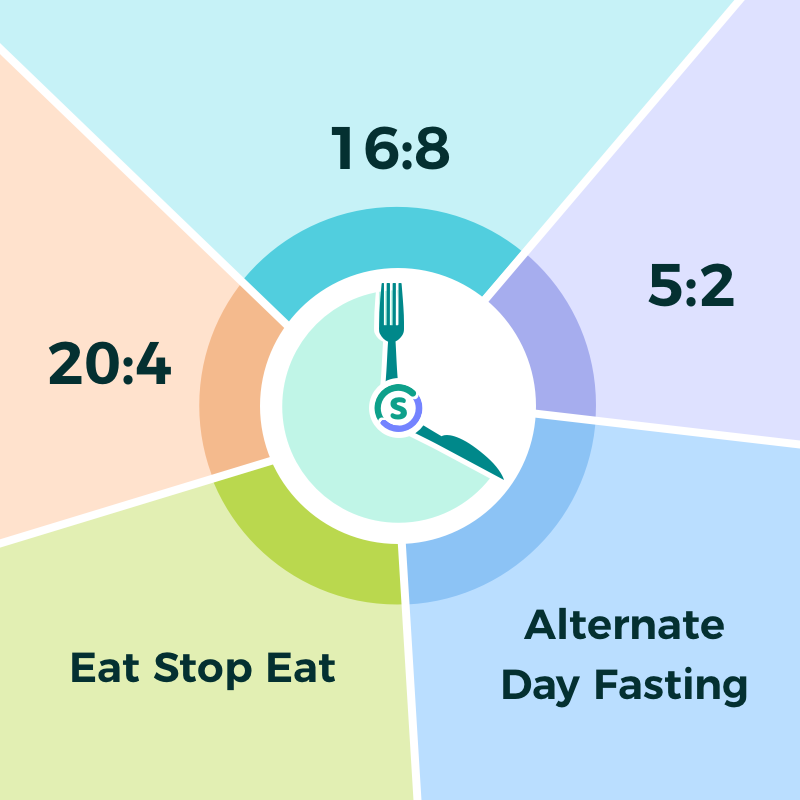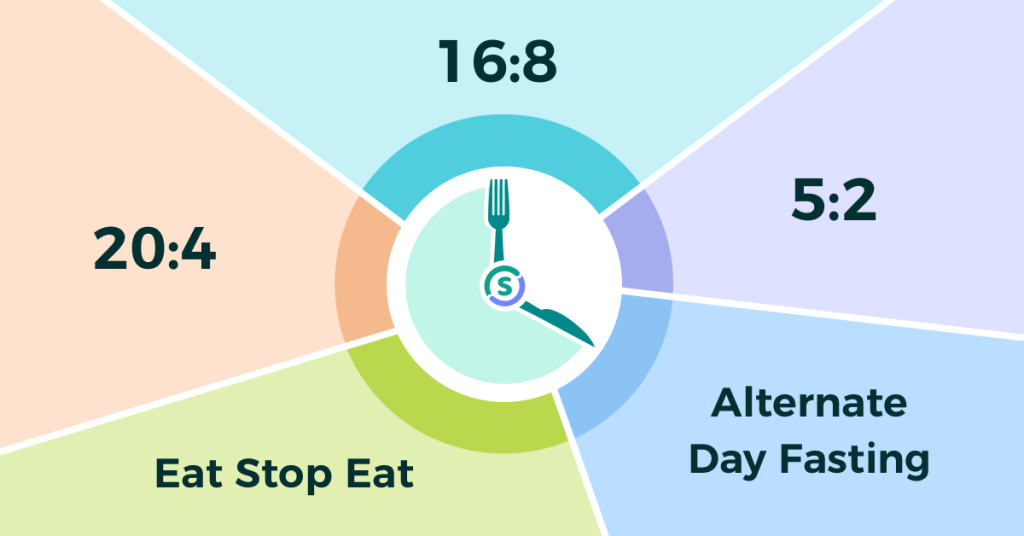If you’ve never tried intermittent fasting before, you definitely have questions about how it works and which approach to take. You must discover the schedule that works best for you in order to succeed with intermittent fasting. It ought to fit in with your everyday schedules, exercise plans, and social activities.
However, it is challenging to know where to start because there are many varieties. Some are more difficult than others, requiring longer periods without food, whereas shorter approaches might not be efficient for your objectives. Continue reading for solutions that will assist you in selecting the best intermittent fasting for you.

What is Intermittent Fasting?
- Everybody fasts every day, although not everyone is aware of it. You already have an eight-hour intermittent fasting period, for instance, if you sleep for eight hours straight every night.
- Intermittent fasting concentrates on when to eat rather than what to eat.
- Intermittent fasting (IF) is another name for it. Additionally, with IF, you must fast occasionally and consume during certain times.
Types of Intermittent Fasting
Once you have an intermittent fasting plan in place, you may discover that there are numerous approaches to IF, but not all of them will work for you due to your habits and way of life. So that after careful analysis, you can choose the option that best suits you. You can choose from the following five varieties of intermittent fasting.
Time-restricted Eating
When using this method of IF, you must adhere to a daily fast of 14 to 16 hours and establish your own feeding window depending on your eating habits. Additionally, it is advised that women avoid fasting for longer than 14 hours a day because it might alter the menstrual cycle and raise the risk of anxiety and sadness. For instance, you can schedule your eating period from 8:00 to 6:00, which can help you avoid skipping any meals and is particularly useful if you have a family who needs to eat every day. Actually, throughout the fasting phase, sleeping takes up the majority of the time. However, if your schedule is unpredictable, you occasionally want to eat every meal, or you want to go out on a late date night, this time-restricted fasting is not for you.
Alternate-day Fasting
Alternate-day fasting was proposed by Krista Varady, Ph.D., a nutrition expert at the University of Illinois in Chicago. It proposes people eat normally on one day and then control their calorie intake to roughly 500 on the second day. Dr. Varady and colleagues observed in a short study that was published in Nutrition Journal that alternate day fasting was successful in assisting obese persons in losing weight. However, this strategy could leave some people feeling undernourished after each meal, making it challenging for certain people to stick to this kind of IF.
See Also: Best 5 Apps for Alternate Day Fasting in 2022
The 5:2 Diet
One of the most common IF strategies are 5:2 fasting, which recommends that you can eat normally for 5 days without a set fasting period but only consume 20% of your usual calories for the other 2 days. The two days of fasting might be any day of your choosing. The 5:2 fasting method is perfect for those who may claim, “I can do anything for two days, but it would be too much to cut back on what I eat all seven days.” This strategy is not advised for people training for strenuous endurance events like a bike or running races, as the two fasting days may leave you feeling lethargic and reduce your capacity for endurance.
Learn More: All You Need to Know about 5:2 Diet
Eat-stop-eat Diet
In the book Eat Stop Eat: The Shocking Truth That Makes Weight Loss Simple Again, the author Brad Pilon proposed the eat-stop diet. By doing this, Brad Pilon highlighted flexibility and emphasized that fasting was only a break from eating. This means that you can carry out a plan to fast for 24 hours once or twice a week in order to avoid extreme dieting every day and maintain a positive attitude. By the way, eat stop eat mixed with regular weight exercise is more useful for individuals who wish to reduce weight.
Learn More: All You Need to Know about Eat Stop Eat Fasting
The Warrior Diet
A more stringent version of intermittent fasting is the Warrior diet. It entails a 20-hour period of fasting, during which specific foods are permitted in little amounts throughout the day, followed by a 4-hour window during which you are free to eat as much as you like in one big feast. The Warrior Diet’s fasting phase is actually more about “undereating.” You may consume a few portions of raw fruit or vegetables, fresh juice, and a few servings of protein throughout the 20-hour fast if you like. This is believed to maximize the “fight or flight” response of the sympathetic nervous system, which is meant to encourage alertness, increase energy, and encourage fat burning.
How to Determine Which Intermittent Fasting Plan is Best for You?
Many dieters find it challenging to adjust to a new eating routine. Changing up your routine can be stressful, and many people may have low energy and hunger, especially at the beginning. Determine the best strategy to manage your meals by considering your lifestyle. For instance, you might want to eat when you have the energy to support your workouts. Take into account a program that makes this easier if you depend on your morning coffee and food to get through the day. More importantly, to give your body time to adjust, start with shorter fasting intervals rather than a 24-hour fast right away.
Three Factors for Selecting an Intermittent Fasting Plan
Making the greatest decision for you when choosing a fasting plan. Here are four factors to think about:
The First Factor: Your Health Condition
The first factor is also the most important thing you should consider when choosing an intermittent fasting plan. Due to its many health advantages, including improved immune function and weight loss, intermittent fasting is generally considered to be safe for people. Because of their physical condition, not everyone should or needs to try intermittent fasting. Some individuals who shouldn’t attempt intermittent fasting include:
- Old folks (since they possibly lack nutrition from the beginning)
- The teenagers whose growth and development are at a key point (because their body needs more nutrients during this period)
- Women who are pregnant, attempting to get pregnant, or who are nursing (because extended fasting periods may throw off your menstrual cycle)
- Those who have diabetes (because fasting blood sugar levels can go too low)
- Those who take numerous medications (because food, or lack of it, can affect absorption and dosage)
- People who are very underweight (because the fasting period may lead to continued weight loss and health problems may also come)
- People who have a history of eating disorders (because the eating and fasting period may cause side effects)
Therefore, always ask for advice from your doctor before beginning a fasting diet.
The Second Factor: Your Feeling
It shouldn’t be challenging to keep intermittent fasting. Throughout your fasts, you should feel fairly at ease. This does not preclude you from being hungry. Hunger will always exist. However, you might want to pause and think twice if the discomfort extends beyond hunger. Here are some indicators that your fasting protocol needs to be modified:
- You’re having trouble sleeping.
- When you’re fasting, you’re not in the best of moods.
- Your level of fitness is slipping
- You experience weakness, fatigue, or stress.
- You don’t like it when family and friends eat in front of you.
- Consider cutting your fast short if you exhibit one or more of these symptoms. Your well-being and comfort are valuable.
The Third Factor: Your Purpose
Do you fast to lose your weight? to remain muscular and lean? Or to gain more health advantages? Before choosing a fasting schedule, be clear about this rationale. The longer regimens are probably more beneficial if you want to lose weight. You’ll eat fewer calories the shorter your feeding window is. However, keep in mind the first factor-comfort. If you’re continually uncomfortable when fasting, you probably won’t continue with the plan. It’s also critical to remember that lengthier fasts are not recommended for preserving or adding muscle. The possibility of calorie and protein limitation is too high.
The Fourth Factor: Your Lifestyle
Your lifestyle has also an impact on how long you fast. Alternate-day fasting might not be for you if your family has a special dinner custom. Perhaps family time comes first. However, generally speaking, fasting frees up your calendar. You can fill such blocks with other activities when meal preparation and eating are not on your mind. For instance, a common productivity trick is skipping breakfast. Food becomes a reward for work well done when it is finally time for a meal.
Some Simple Tips for Starting Your First Fast
If you decide to try fasting, bear the following general advice in mind:
- Drink enough water. Staying adequately hydrated will make the fasting periods much easier to endure.
- Try to fast all night long as a treat to yourself. In this manner, at least eight of those hours will be spent sleeping (ideally).
- Rewire the way you think. Imagine yourself fasting as taking a break from eating rather than going without. It can be a way to break up the routine of constantly wondering about what to eat next and when. You must adopt this thinking way if you want to sustain a fasting regimen.
- Take supplements. Regular fasting could cause you to miss out on important nutrients. This is because eating fewer calories on a regular basis makes it more difficult to meet your nutritional demands. In fact, those who follow weight loss programs are more likely to lack a variety of vital minerals, including iron, calcium, and vitamin B12. So take some supplements to ensure the nutrients.
- Go to the gym. You’ll see better results by combining intermittent fasting with regular exercise. It doesn’t have to be extreme or outlandish. Simply doing a full-body strength workout twice or three times a week can suffice.
